Abstract
A review of 87 cases of microbial keratitis in South Australia was made to determine the factors which influence the outcome of the disease. The preceding pathology and the extent of ulceration at presentation were found to be significant, while the presence of hypopyon was less important. Infection with Pseudomonas aeruginosa was most likely to result in a poor outcome. Most patients had a history of traumatic injury, herpes simplex keratitis, or a corneal graft. The choice of gentamicin and a cephalosporin as appropriate initial therapy in Australia was supported. The results are discussed with reference to current research objectives.
Full text
PDF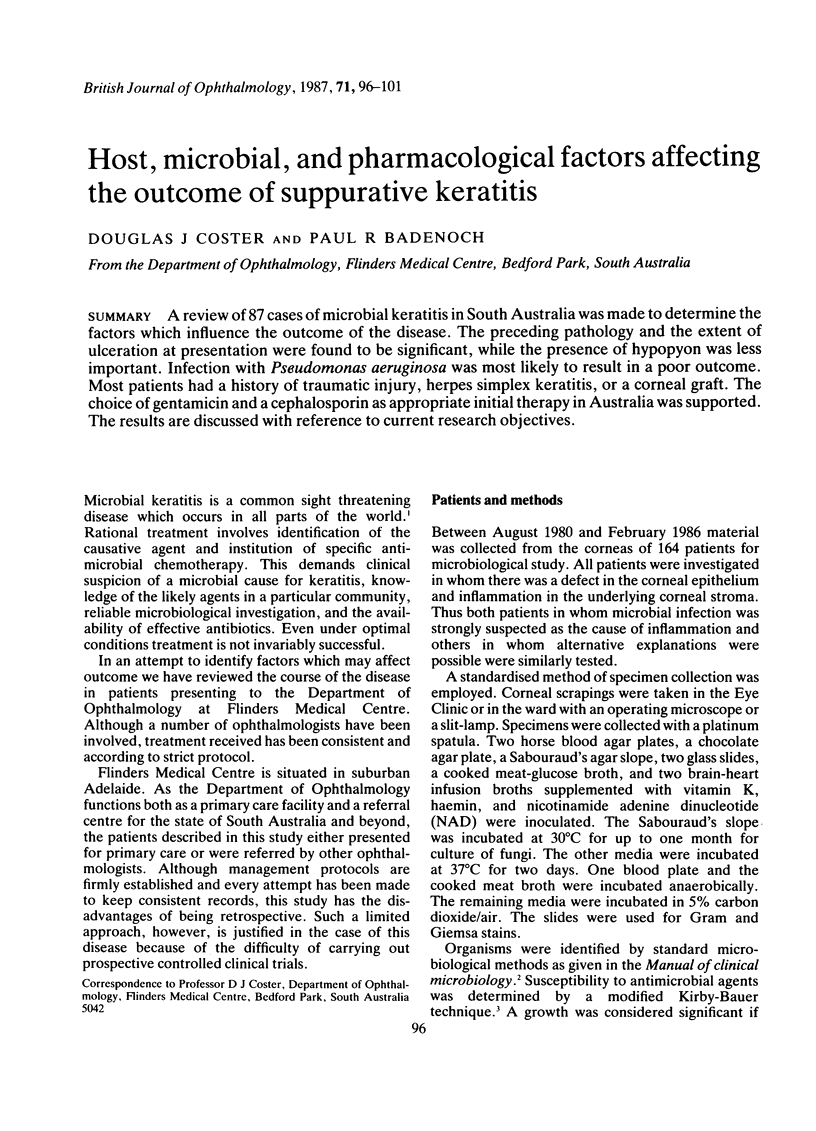
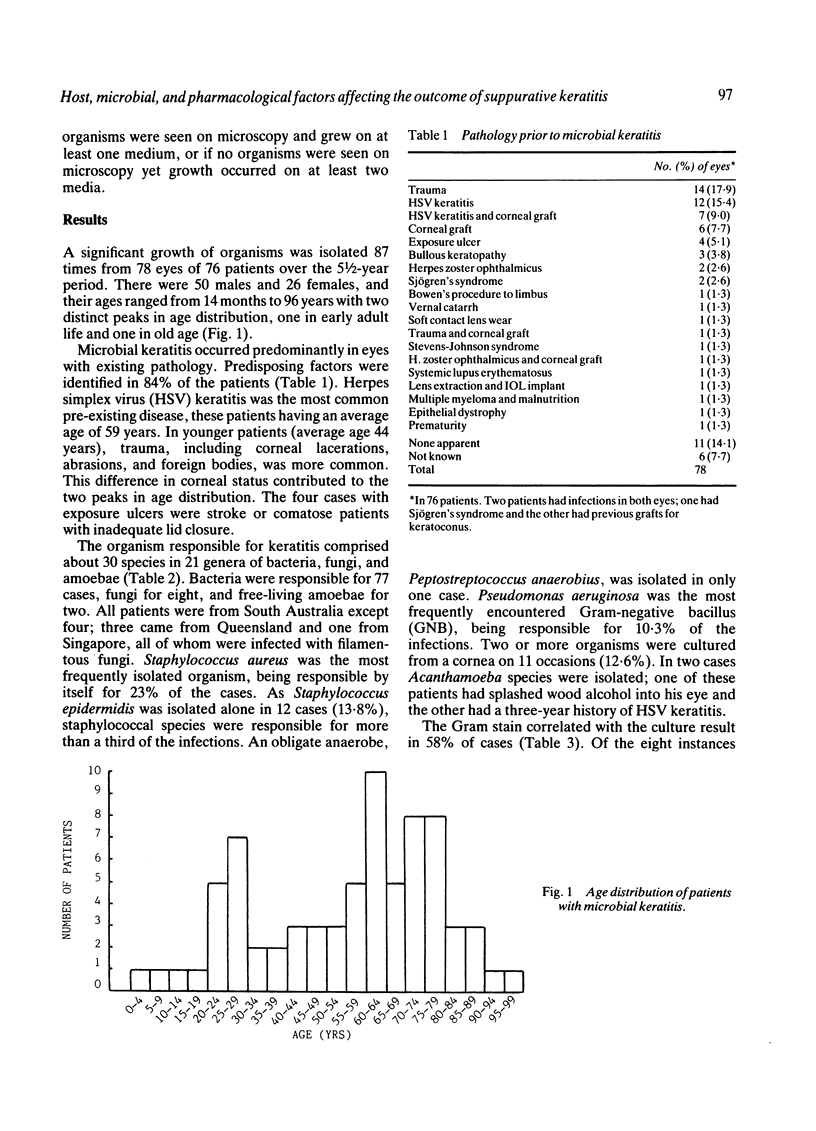
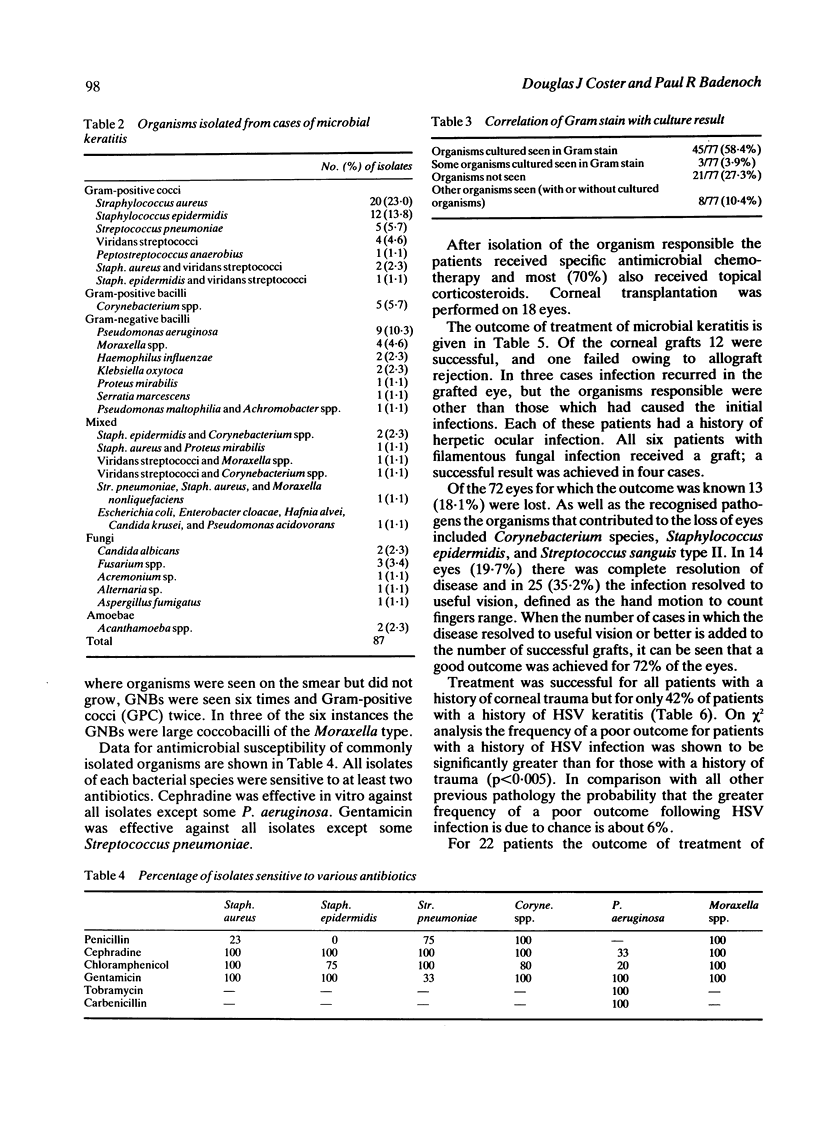
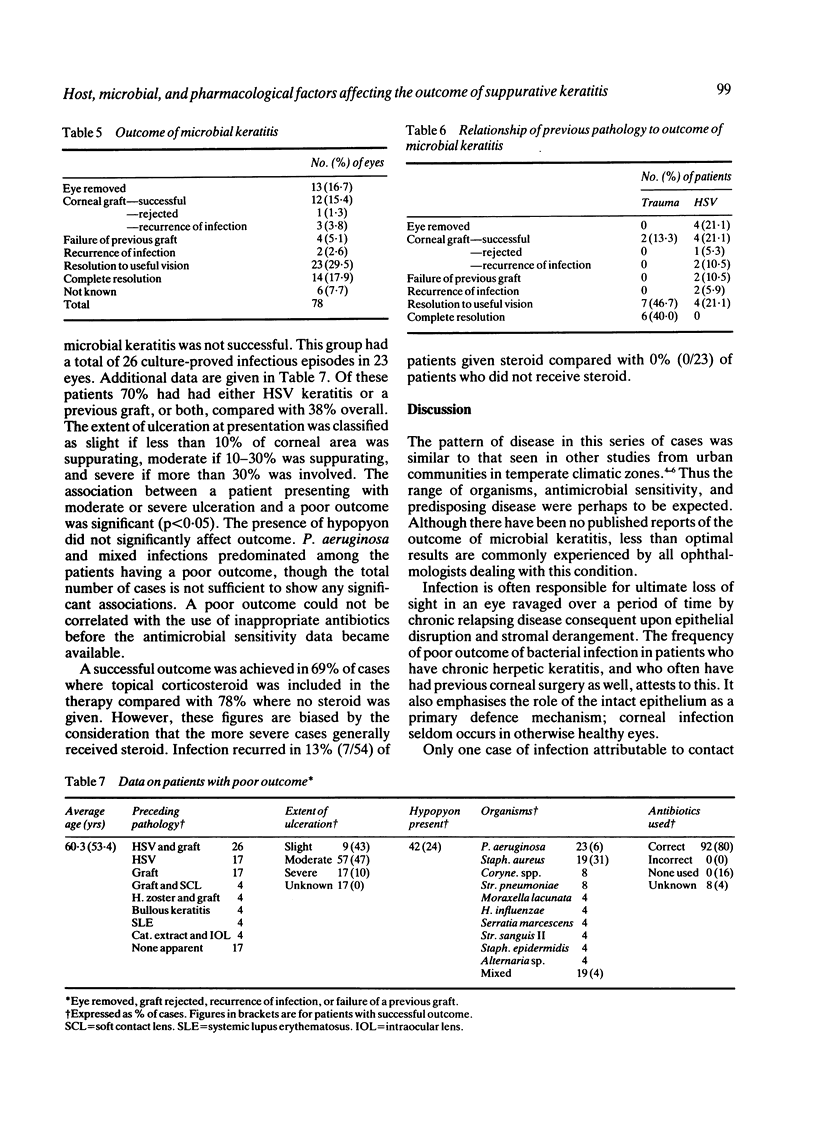
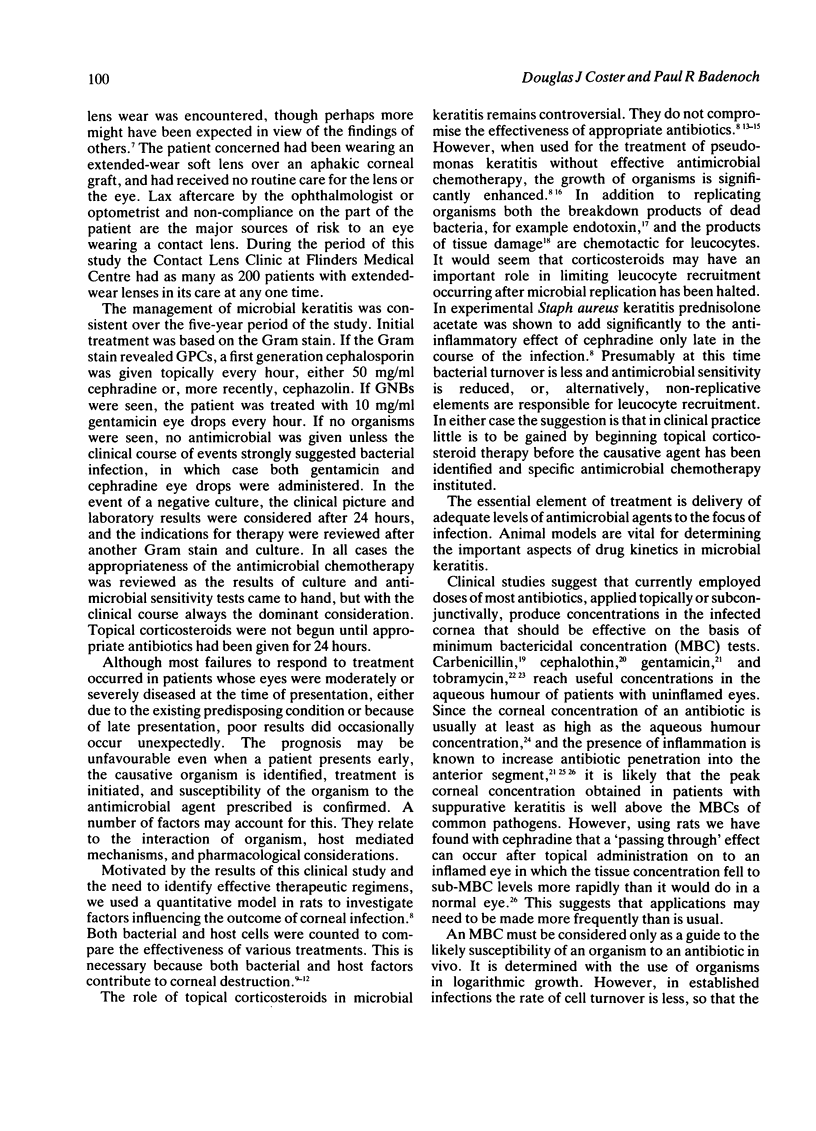
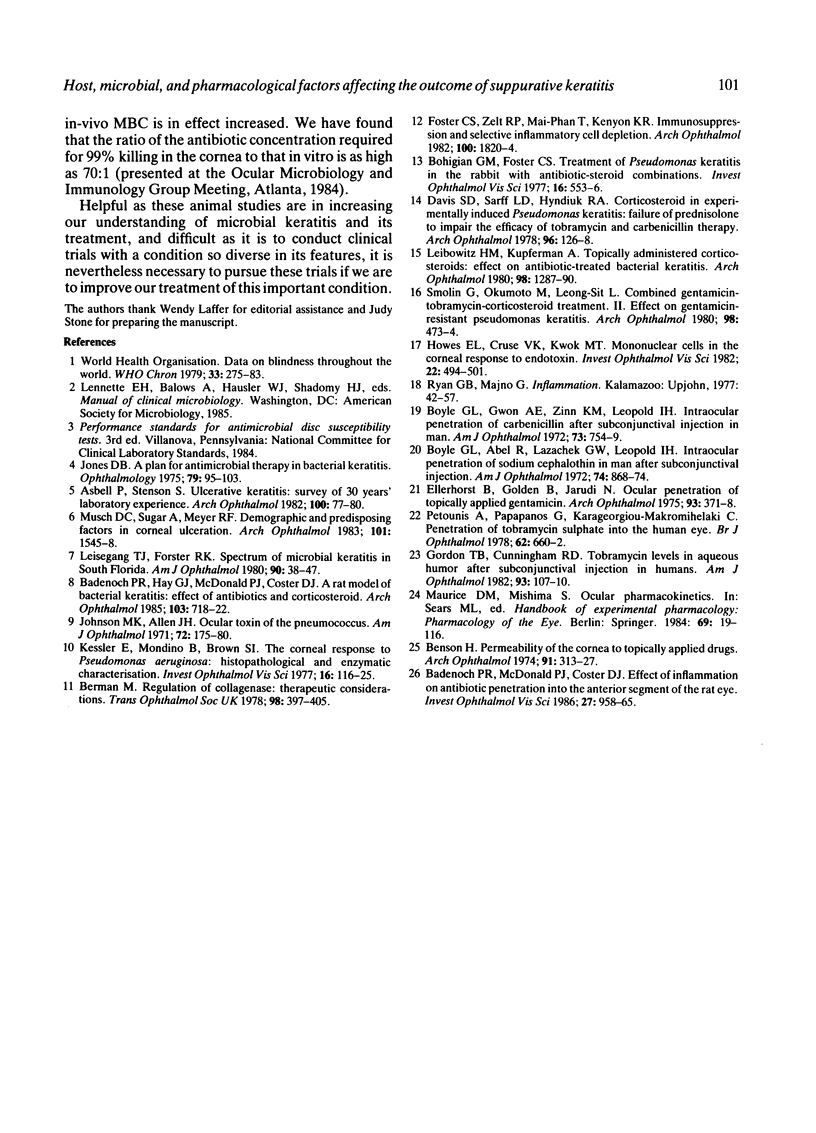
Selected References
These references are in PubMed. This may not be the complete list of references from this article.
- Asbell P., Stenson S. Ulcerative keratitis. Survey of 30 years' laboratory experience. Arch Ophthalmol. 1982 Jan;100(1):77–80. doi: 10.1001/archopht.1982.01030030079005. [DOI] [PubMed] [Google Scholar]
- Badenoch P. R., Hay G. J., McDonald P. J., Coster D. J. A rat model of bacterial keratitis. Effect of antibiotics and corticosteroid. Arch Ophthalmol. 1985 May;103(5):718–722. doi: 10.1001/archopht.1985.01050050110028. [DOI] [PubMed] [Google Scholar]
- Badenoch P. R., McDonald P. J., Coster D. J. Effect of inflammation on antibiotic penetration into the anterior segment of the rat eye. Invest Ophthalmol Vis Sci. 1986 Jun;27(6):958–965. [PubMed] [Google Scholar]
- Benson H. Permeability of the cornea to topically applied drugs. Arch Ophthalmol. 1974 Apr;91(4):313–327. doi: 10.1001/archopht.1974.03900060323017. [DOI] [PubMed] [Google Scholar]
- Berman M. Regulation of collagenase. Therapeutic considerations. Trans Ophthalmol Soc U K. 1978 Sep;98(3):397–405. [PubMed] [Google Scholar]
- Bohigian G. M., Foster C. S. Treatment of Pseudomonas keratitis in the rabbit with antibiotic-steroid combinations. Invest Ophthalmol Vis Sci. 1977 Jun;16(6):553–556. [PubMed] [Google Scholar]
- Boyle G. L., Abel R., Jr, Lazachek G. W., Leopold I. H. Intraocular penetration of sodium cephalothin in man after subconjunctival injection. Am J Ophthalmol. 1972 Nov;74(5):868–874. doi: 10.1016/0002-9394(72)91207-x. [DOI] [PubMed] [Google Scholar]
- Boyle G. L., Gwon A. E., Zinn K. M., Leopold I. H. Intraocular penetration of carbenicillin after subconjunctival injection in man. Am J Ophthalmol. 1972 May;73(5):754–759. doi: 10.1016/0002-9394(72)90393-5. [DOI] [PubMed] [Google Scholar]
- Davis S. D., Sarff L. D., Hyndiuk R. A. Corticosteroid in experimentally induced Pseudomonas keratitis: failure of prednisolone to impair the efficacy of tobramycin and carbenicillin therapy. Arch Ophthalmol. 1978 Jan;96(1):126–128. doi: 10.1001/archopht.1978.03910050082021. [DOI] [PubMed] [Google Scholar]
- Ellerhost B., Golden B., Jarudi N. Ocular penetration of topically applied gentamicin. Arch Ophthalmol. 1975 May;93(5):371–378. doi: 10.1001/archopht.1975.01010020383014. [DOI] [PubMed] [Google Scholar]
- Foster C. S., Zelt R. P., Mai-Phan T., Kenyon K. R. Immunosuppression and selective inflammatory cell depletion. Studies on a guinea pig model of corneal ulceration after ocular alkali burning. Arch Ophthalmol. 1982 Nov;100(11):1820–1824. doi: 10.1001/archopht.1982.01030040800019. [DOI] [PubMed] [Google Scholar]
- Gorden T. B., Cunningham R. D. Tobramycin levels in aqueous humor after subconjunctival injection in humans. Am J Ophthalmol. 1982 Jan;93(1):107–110. doi: 10.1016/0002-9394(82)90708-5. [DOI] [PubMed] [Google Scholar]
- Howes E. L., Cruse V. K., Kwok M. T. Mononuclear cells in the corneal response to endotoxin. Invest Ophthalmol Vis Sci. 1982 Apr;22(4):494–501. [PubMed] [Google Scholar]
- Johnson M. K., Allen J. H. Ocular toxin of the pneumococcus. Am J Ophthalmol. 1971 Jul 30;72(1):175–180. doi: 10.1016/0002-9394(71)91610-2. [DOI] [PubMed] [Google Scholar]
- Kessler E., Mondino B. J., Brown S. I. The corneal response to Pseudomonas aeruginosa: histopathological and enzymatic characterization. Invest Ophthalmol Vis Sci. 1977 Feb;16(2):116–125. [PubMed] [Google Scholar]
- Leibowitz H. M., Kupferman A. Topically administered corticosteroids: effect on antibiotic-treated bacterial keratitis. Arch Ophthalmol. 1980 Jul;98(7):1287–1290. doi: 10.1001/archopht.1980.01020040139024. [DOI] [PubMed] [Google Scholar]
- Liesegang T. J., Forster R. K. Spectrum of microbial keratitis in South Florida. Am J Ophthalmol. 1980 Jul;90(1):38–47. doi: 10.1016/s0002-9394(14)75075-5. [DOI] [PubMed] [Google Scholar]
- Musch D. C., Sugar A., Meyer R. F. Demographic and predisposing factors in corneal ulceration. Arch Ophthalmol. 1983 Oct;101(10):1545–1548. doi: 10.1001/archopht.1983.01040020547007. [DOI] [PubMed] [Google Scholar]
- Petounis A., Papapanos G., Karageorgiou-Makromihelaki C. Penetration of tobramycin sulphate into the human eye. Br J Ophthalmol. 1978 Sep;62(9):660–662. doi: 10.1136/bjo.62.9.660. [DOI] [PMC free article] [PubMed] [Google Scholar]
- Smolin G., Okumoto M., Leong-Sit L. Combined gentamicin-tobramycin-corticosteroid treatment. II. Effect on gentamicin-resistant Pseudomonas keratitis. Arch Ophthalmol. 1980 Mar;98(3):473–474. doi: 10.1001/archopht.1980.01020030469004. [DOI] [PubMed] [Google Scholar]


